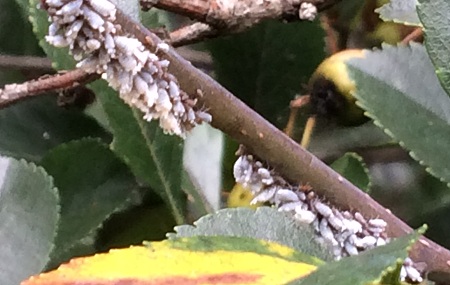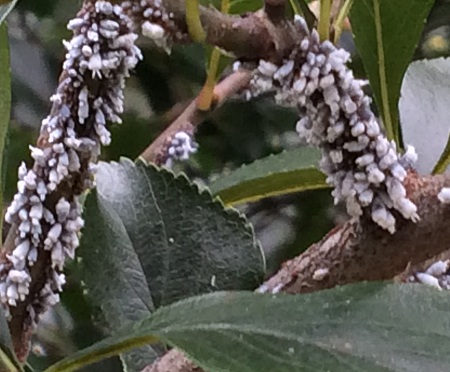Aphid Control

Aphids are a small, hard to see insect that suck the fluids out of plants for food. They are a slow moving insect, but they can multiply quickly. Usually found in large groups, the damage they can cause can be significant. All plants are susceptible to being eaten by one type of aphid or another.
Identifying Aphids
Most aphids are tiny, usually smaller than 1/8” long, and often go unnoticed by the human eye. Aphids can be many different colors, depending on the type, including white, black, gray, brown, light green, red, and yellow. All have pear shaped bodies with antennas. Some aphids have a wooly or waxy look to them (a secretion from the insect), and are usually identified by the same characteristic. For those who are very interested, the tell-tale signs of an aphid are long legs and two tubes rising backwards out of the tail end of the insect. Additionally, unlike other leaf eating insects, aphids are not skittish and don’t move too quickly when disturbed.
Aphid Damage

Both young and mature aphids damage your plants, both by feeding on the juices of the leaves stems and roots, depending upon the type of aphid. The new growth of a plant is usually the most susceptible part of the plant, with the woody limbs being less likely to be eaten. When looking for aphids, look for misshapen leaves or curling yellow leaves, often with a sticky substance (Honeydew) on the leaf. Often you will see other insects like ants which eat the Honeydew as food. Branches and leaves can also look black in color because the Honeydew can develop a fungus called Smooty Mold which can turn black with time. Rarely aphids can also cause galls to form on leaves and roots.
Aphid Control
There are two main types of control for aphids; chemical and biological.
- Our licensed technicians have several chemical insecticides that will treat your aphid infestation. Please call our office for an estimate.
- Biological control is somewhat difficult and not a service we offer. However, Lady Beetles are one form of biological control that is commercially available. Another biological control is to control the ant population that protects the aphids. Use a commercially available ant trap or sticker to control the ants, and natural predators such as wasps will be very helpful in aphid control.
Do-It-Yourself Aphid Control
A couple of methods for removing aphids from your plants or vegetables are easy and doable by homeowners.
- Spraying a stream of cold water onto the leaves and stems sometimes is enough to dislodge them from your plants.
- A mild solution of dishwashing soap (ivory) and water wiped onto the plant leaves and stems will get rid of aphids.
- Isopropyl alcohol will also dislodge most aphids. Mix it with water, or spray it straight, and spray the plant every two to three days for a few weeks.
- Lady Beetle control is also temporarily effective. If you choose this method, keep you Lady Beetles in a refrigerator and release them on your plants at dusk.



A big thank you for you diligent work on our property, we are very happy with how our lawn and plants look. All of the residents here … read more